The final list of autumn work in the vineyard is an event - sheltering grapes for the winter is required not only in the northern regions, but and in the middle lane. Even frost-resistant varieties can suffer from sudden changes in temperature, little snowy winter or too much rainfall. It is impossible to answer in a clear-cut way how to protect the grapes correctly; the optimal methods of sheltering and materials determine the specific growing conditions.
Content
When and what kind of shelter is needed
Shelter for the winter is necessary to protect the vines and roots from the effects of freezing temperatures, cold winds, and excess snow. There are many options for winter shelters for grapes, the choice of which is determined by climatic conditions and plant condition.
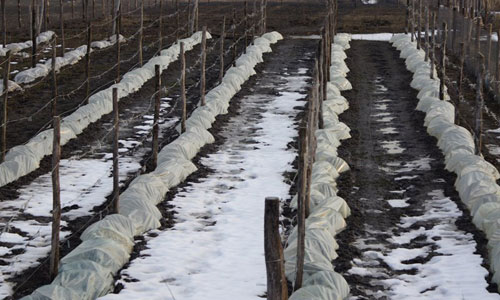
Grape Features
When choosing a wintering option, you need to consider the potential vulnerability of a particular bush:
- Not all grape varieties tolerate cold equally. Determine the timing and density of the shelter will help frost resistance indicators specified in the description of the variety.
- Resistance to frost in young plants is lower compared to adult bushes due to a thinner layer of bark.
- A bush that is distinguished by a large harvest is at greater risk of freezing out than its less fertile harvest, because fruiting consumes a lot of resources, weakening the vine.
Degree of protection
When organizing shelters, one should not be guided by the principle "the more the better." It is important not only to isolate the vine bushes from the cold air, but to provide optimal conditions for the winter period, otherwise the plants may vytryat.
According to the degree of protection, 3 types of shelter are distinguished:
- Hilling or digging. Provides grapes a good wintering if the temperature does not fall below -15 ° C. It is advisable to use for the protection of frost-resistant varieties.
- Half shelter. The method is practiced in regions with mild and snowy winters. Shelter primarily provides root protection. The lower part of the bush is spudded with a layer of soil, agrofibre or tarpaulin and a thin layer of mulch (5 cm) are placed on top of the vines.
- Full shelter. Suitable for harsh winters. The vine, sprinkled with a thick layer of mulch, is additionally covered with shields or dense material.
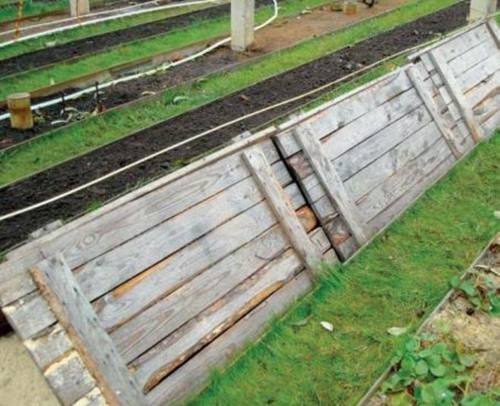
Shelter Dates
Harbor grapes for the winter in the middle lane you need around mid-November. In the central part of Russia (Moscow region), the procedure is usually carried out at the end of November or in early December. Siberian autumn may force to hide bushes in September.
Do not do it cover grapes at positive temperatures, especially in rainy autumn - soaked vines can crack in frost. It is advisable to carry out the procedure when the soil is already frozen and will no longer thaw.
Vines easily tolerate frosts down to -5 ° C. When laid on the ground, it is useful to hold them for 3-5 days at -5 ... -8 ° C - slight frosts increase resistance to cold.If the grape variety is not frost-resistant, temperatures below -10 ° C will be critical for it, and at -12 ° C the plant will die.
Grape Shelter Procedure
The main task of shelter for the winter is to warm the root. If the vine freezes, the plant can still be reanimated, but freezing the roots will lead to the death of the entire bush. Therefore, regardless of the method of sheltering, the root should be sprinkled with a layer of soil, and put at least 5 cm of a layer of mulch on top.
Ways of laying vines
Before as cover grapes for the winter, the vine must be removed from the support and laid on the ground. In regions with mild and snowy winters without thawing risks, you can lay branches on the ground, in other cases it is worth using one of the options:
- Trench. The method is suitable for grapes grown in regions with harsh or snowless winters and in areas not protected from the wind. Optimal for earthing up vines. Near the bush, you need to dig a furrow 30 cm deep and place a connected vine there. For additional protection against frost, shoots can be wrapped in burlap.
- Flooring. The laying method is recommended if in winter the soil may thaw due to thaws, as well as when mulching with materials prone to dampness. The vine should be placed on a layer of boards, logs, spruce branches, tree branches.
Types of Shelter
The vines laid on the ground should be placed under a warming cover. There are two principles for sheltering grapes:
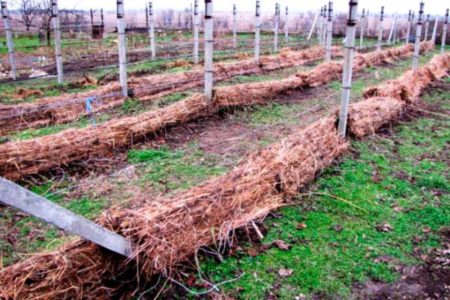
- Wet. The vines are covered with mulch - straw, spruce branches, soil. The method is relevant if there is a lot of snow in winter or significant temperature fluctuations occur. Usually used in regions middle strip.
- Dry. The grapes are covered with shields or waterproof materials, and a layer of mulch is placed on top. In this case, the grapes are protected from severe frost and wind. The method is used in the northern regions, where there is no risk of thaws in the winter.
Shelter of young grapes
To shelter annual bushes and seedlings requires a special technology:
- Annual grapes are low, so the vines can not be removed from the supports. A cone-shaped frame should be installed around the bush. Its function can be performed by stakes knocked into the ground, connected by the tops, or a net-chain.
- The frame must be covered with agrofibre or other material. If the cover does not let air through, leave a gap for ventilation.
- The space between the cover and the bush should be filled with loose mulch - leaves, straw or spruce branches.
Force majeure
If the gardener was late with the installation of the shelter, but the arrival of frost accompanied the snowfall, there is a chance that the plant was not badly damaged. In this case, it is necessary to fill the bush with a half-meter layer of snow.
If the temperature has fallen sharply, and the snow falls on wet ground, the vine needs to be raised above the ground, laying a spruce or boards under it, and wrapped with agrofibre. A layer of snow should be scribbled on top.
In case of a thaw, you need to cover the bushes according to the original plan. If the snow lies before spring, the grapes can safely winter under its protection.
Covering materials
The choice of material for shelter depends on the standard temperature and rainfall. Important characteristics of the material will be its:
- density;
- impermeability;
- breathability.
Soil tilling
For protection in the form of an earthen hill above the bush, you need to use loose, preferably loamy soil. Moisture collects under the clay soil around the vines, freezing which damages the wood, and in the spring heavy soil warms up slowly, making it impossible to remove the shelter on time.
The ground for hilling should be dry, it should be prepared in advance.Often the soil is taken from the row-spacing, but it is unsafe if the bush of grapes is not young and tall - the roots reaching this section can freeze.
Before hilling, the vine must be placed in a trench. If severe frosts are expected, a layer of fallen leaves or straw should be made in the soil. The thickness of the layers of each layer is 15 cm, their number depends on the required thermal insulation, but the top layer should be the soil. The total thickness of the covering layer can vary from 15 to 50 cm. The diameter of the embankment must correspond to the size of the root system, the minimum figure is 30 cm (for annual grapes).
Mulch
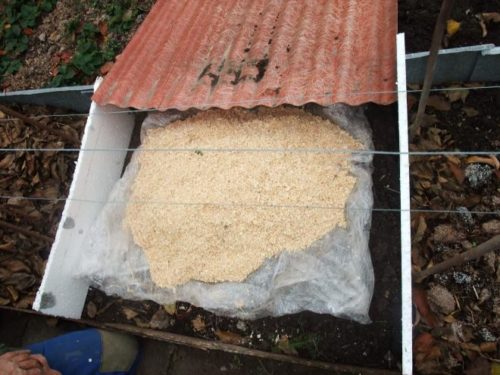 For winter shelter, the mulch should have lightness and friability. In all cases, it is preferable to place the vines on the flooring; otherwise, each material has its own laying requirements:
For winter shelter, the mulch should have lightness and friability. In all cases, it is preferable to place the vines on the flooring; otherwise, each material has its own laying requirements:
- Coniferous branches. The best option for grapes - lapnik does not interfere with air circulation, delays snow. Substances contained in pine or spruce branches repel rodents and prevent the development of fungi and mold under cover. The layer thickness should be about 30-40 cm.
- Straw. It is recommended to put in 2 sets as frosts increase. A layer of 40 cm is required. From above, the straw needs to be fixed - sprinkled with snow or covered with spanbond, otherwise the mulch will be blown away by the wind. Reed can replace straw.
- Woody leaves. The material should be dry, but you need to dry the fallen leaves immediately after collection, and not before laying. The method of mulching is similar to shelter with straw.
- Sawdust. They are distinguished by high thermal insulation qualities, but they are easily moistened and retain moisture for a long time, so they can only be used as part of the dry method. Several layers of film should be put under the vine, and after mulching, install slate or wood shields over the bush.
Snow protection
It is not necessary to place any additional layer between the bush and the snow. If there is enough snow and there is no risk of thaw, you can lay it directly on the branches with a layer of 40-50 cm.
The snowdrift above the bush needs to be slightly tamped so that it is not destroyed by the wind. Vines under such a "mulch" is recommended to be laid on the floor.
Slate or plywood
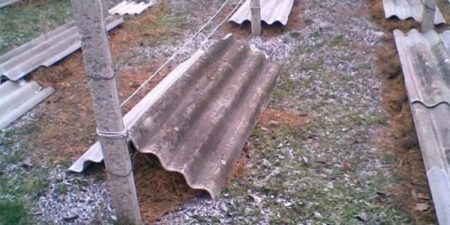 Materials are used as shields as part of a dry shelter method. In this case soil under the vine should be lined with a film, and on top cover the bush with a layer of leaves or straw. Above the grapes you need to install sheets of slate or plywood in the form of a pitched roof. The joints between the shields must be covered with a waterproof material (film, roofing material), sprinkled with them to fix the soil. Shields can be insulated by placing burlap, paper, cardboard boxes on top of them that need to be covered with layers of leaves and soil.
Materials are used as shields as part of a dry shelter method. In this case soil under the vine should be lined with a film, and on top cover the bush with a layer of leaves or straw. Above the grapes you need to install sheets of slate or plywood in the form of a pitched roof. The joints between the shields must be covered with a waterproof material (film, roofing material), sprinkled with them to fix the soil. Shields can be insulated by placing burlap, paper, cardboard boxes on top of them that need to be covered with layers of leaves and soil.
Artificial materials
In rare cases, synthetic covering materials can be used as self-sufficient protection of grapes, more often they are combined with mulch, earthen mound or shields.- Agrofibre. Without additional insulation, the material can be used only in the southern regions. In this case, it is allowed to cover or wrap the vines without removing it from the trellis. Colder winters or alternating thaws and drops in temperature will require increased cover with a layer of mulch. Spanbond passes moisture, so you need to lay the flooring under the vine.
- Ruberoid. Suitable for sheltering vineyards growing in warm, but snowless winters. The vines must be placed in the grooves and covered with roofing material on top. The material is impervious to water and air, it is necessary to leave gaps for ventilation. When frosts increase without snow, a layer of mulch should be put on top of the roofing material.
- Film.Material is used when it is important to prevent rainfall from getting on the vine. But the film will not protect against frost, it can be used only as an additional cover, for example, together with mulch. Shelter is made like a greenhouse - the material needs to be pulled over arcs installed above the bush. The edges of the film should be sprinkled with soil, leaving a gap for air circulation on one side. It is important that there is a layer of air between the film and the vine - the areas that will touch the thin cover will freeze.
- Polymer film. One of the serious drawbacks of film sheeting is the formation of condensation on the inner surface of the material. Because of this, damage to the bushes with fungi and rot is likely. But if you use a high-density polymer film with reflective properties, there will be no problem with moisture.
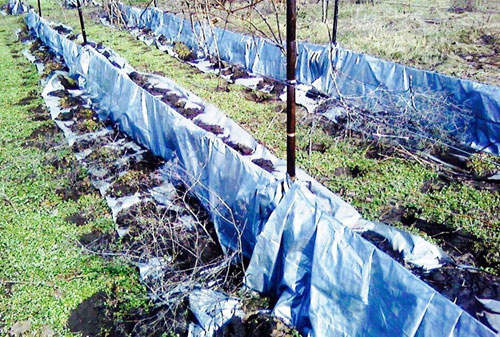
Protection of the shelter from fungi and rodents
Some covering materials favor development diseases or pest colonies, so care must be taken to protect the grapes.
- Rats or mice can penetrate the shelter and gnaw the vines, therefore poisoned baits should be left near the bush. To the appearance of rodents, mulching with straw, sawdust and dry leaves has.
- It is important that the leaves used to mulch the bushes are not infected with the fungus. You can only take material from healthy trees.
- The use of a film as a covering material increases the risk of fungi on grapes. Their spores can remain on the film from last year, so when reusing the cover you need to process with copper sulfate (4%) and leave to dry without washing the solution.
- Around the bush, you can lay out dried bunches of herbs with the ability to repel insects. This tansy, wormwood, marigolds, calendula.
Weather in the fall is unpredictable, so it is important to monitor the temperature in order to remove the bushes under cover in time. It is important to choose the type of protection suitable for the climate and materials so that the grapes are not affected by either cold or heat, humidity or fungus.




 Non-covering winter-hardy grape varieties for Moscow region
Non-covering winter-hardy grape varieties for Moscow region How to keep the vine in winter
How to keep the vine in winter When can I transfer grapes to another place in the fall
When can I transfer grapes to another place in the fall How to cover and prepare grapes for the winter in the suburbs
How to cover and prepare grapes for the winter in the suburbs